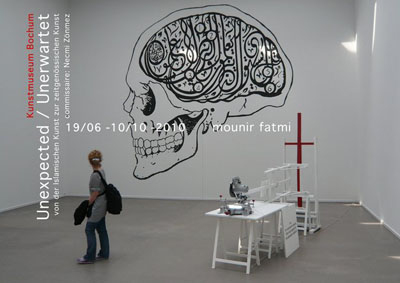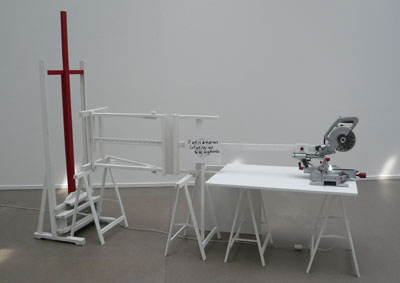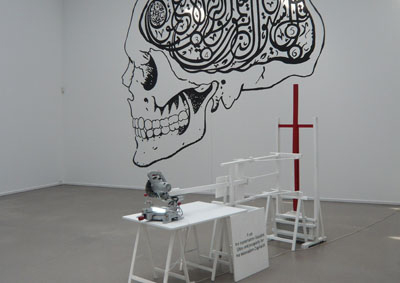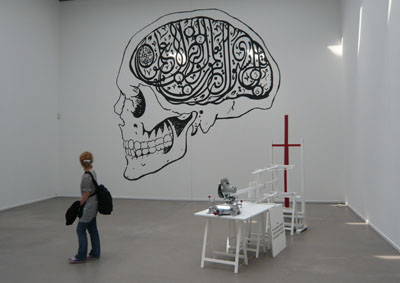|
|
Unexpected
Kunstmuseum Bochum 18.6.2010 – 10.10.2010 Curator: Necmi Sönmez
"UNERWARTET / UNEXPECTED – From Islamic Art to Contemporary Art" is a project of the Kunstmuseum Bochum in the framework of the Ruhr art museums’s joint presentation titled Mapping the Region and marking the occasion of the European Cultural Capital RUHR.2010. The exhibition operates on three levels. The starting point is large-format photography by the Finnish artist Tuomo Manninnen that presents ten families with roots in Islamic countries. Some of these families are already living in the third or fourth generation in various cities of the Ruhr Valley; they show themselves in their current surroundings. On a second level, works are shown by contemporary artists (Hamra Abbas, Arahmaiani, Lara Baladi, Mounir Fatmi, Tarek Al-Ghoussein, Özlem Günyol & Mustafa Kunt, Arash Hanaei, Shady El Noshokaty, Zineb Sedira, and Nebojša Šeric Shoba) from the respective ancestral countries of the chosen families. This creates a link between migration and contemporary art. To further illuminate the reference points between the successfully integrated families and current art from the respective Islamic-molded home countries, examples of classical Islamic art are presented as the exhibition’s third level. This intertwines tradition, the present, and fractures in the tradition in the context of their current meaning. The interdisciplinary exhibition operates with mirrorings and interactions among these three levels and consciously rejects simplifying and clichéd statements and determinations. The terms "Islam", "culture", and "contemporary art" have divergent associations in the cultural-political interactions between East and West. A final clarification of these problematic concepts is complex and not the goal of this project, especially since the contemporary part of the exhibition is not able to and does not seek to depict general Islamic art or culture as such, but primarily focuses on the strategies of the younger generation of artists. The latter demonstrate quite autonomously their view of the world in which they live. The "contemporary image making" of their works is determined by a perception that often makes use of fragmentary, surrealistic, or poetic means and components, independent of regional, ethnic, and historical circumstances. For observers of present-day constellations between the Orient and the Occident, it is easy to understand why writers and artists whose roots lie in Islamic-molded cultures reject being politically, sociologically, or aesthetically categorized on the basis of their religious affiliation; they rightly point out that these categories originate primarily in Western ideas and prejudices. Central Europeans find it hard to understand why such categorizations have negative associations in Islamic cultures. The supposed superiority of the European value system over the art of other cultures, especially countries molded by Islam, derives from colonialism. To this day it is hardly possible to view contemporary art from these countries from a viewpoint of equality, without oversimplifications and overgeneralizations. The title "UNERWARTET / UNEXPECTED" reflects a Eurocentric art public’s usual first reaction to current art from Islamic cultures. A primary aim of the exhibition is the attempt to perceive the transfer of new cultural experiences and exchange relationships. Up to now, kindred exhibitions in the German-speaking world (for example, DisORIENTation, Contemporary Arab art production from the Middle East, Haus der Kulturen der Welt, Berlin 2003; TASWIR, Islamische Bildwelten und Moderne, Martin Gropius-Bau, Berlin, 2010) have concentrated on simple "presentations" or on a "call for dialog"; but a different form of depiction is being tested in the Kunstmuseum Bochum. Making the viewers aware of migration from Islamic countries to the Ruhr Valley is thereby the thread running through the exhibition. Immigrants to the Ruhr Valley initially came with no further perspective than residence for a limited time, but soon they began coming with the firm prospect of spending the rest of their lives in this region. Despite initial difficulties, the successful integration of the second and third generation of "Gastarbeiter" children shows the progress that has meanwhile been made in terms of equal chances and equality between natives and immigrants in the Ruhr Valley. This is one of the most important statements of the photos by Tuomo Manninen. In their prose, the poets Nazim Hikmet, Mahmoud Darwish, and Adonis often call creative people "internal immigrants" who, with differing motives, take new paths. So a comparison is definitely possible between the "Gastarbeiter" of the old days and artists, and this exhibition has experimentally carried it out. Curiosity about a "new life" in unknown, alien surroundings and the wish to flee social, political, and cultural constraints are comparable motives and driving forces for both groups. The biographies of migrants and artists often read like processes of emancipation. The certainty of returning soon to their homeland was a prerequisite for most "Gastarbeiter" to be willing to go to another country. Almost half of the artists invited to the exhibition live and work "away from home". They constantly commute between the place where they work and the place where they were born, seeking new ideas that frequently become the objects of their artistic projects. Some aspects of the exhibition may seem "transitory", because they reflect various traditions of the old homeland in transition to the new one. Almost all these works combine interest in history and its continued effects in the new living circumstances. But the point is not the history of the Orient as a delimited area, but rather world history, whose political consequences are especially palpable in countries shaped by Islam. The "wind" that seems to blow in all corners of the exhibition rooms comes mainly from the south and southeast.
Bochum, June 2010 |



